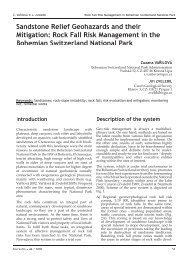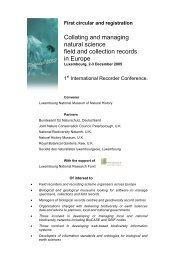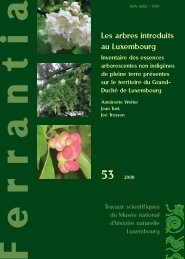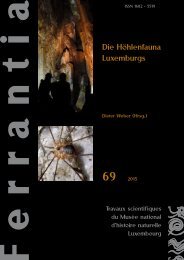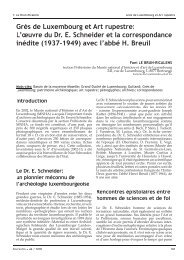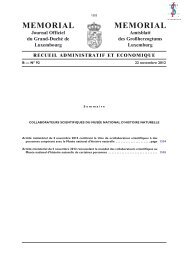Overview of the geology of the Luxembourg Sandstone(s)
Overview of the geology of the Luxembourg Sandstone(s)
Overview of the geology of the Luxembourg Sandstone(s)
Create successful ePaper yourself
Turn your PDF publications into a flip-book with our unique Google optimized e-Paper software.
R. Colbach <strong>Overview</strong> <strong>of</strong> <strong>the</strong> <strong>geology</strong> <strong>of</strong> <strong>the</strong> <strong>Luxembourg</strong> <strong>Sandstone</strong>(s)<strong>Overview</strong> <strong>of</strong> <strong>the</strong> <strong>geology</strong> <strong>of</strong> <strong>the</strong> <strong>Luxembourg</strong><strong>Sandstone</strong>(s)Robert COLBACHService géologique du <strong>Luxembourg</strong>43, bd G.-D. Charloe, Charloe, Charloe, Charloe, L-1331 <strong>Luxembourg</strong>robert.colbach@pch.etat.luIn <strong>the</strong> nor<strong>the</strong>astern tip <strong>of</strong> <strong>the</strong> Paris Basin ("<strong>Luxembourg</strong>-TrierGulf") <strong>the</strong> Lower Liassic, o<strong>the</strong>rwiseformed by blueish grey limestone-shale alternations("Blue Liassic") also called "Lorrainefacies", shows lenticular insertions <strong>of</strong> arenaceoussediments referred to as <strong>the</strong> <strong>Luxembourg</strong><strong>Sandstone</strong>(s) Formation. This unit includes, fromSE to NW, <strong>the</strong> local denominations <strong>of</strong> Heange,Ernzen, Metzert, Virton, Orval or Florenvillesandstones (Fig. 1).PalaeogeographyThe lower mesozoic history <strong>of</strong> <strong>the</strong> considered areawas strongly influenced by <strong>the</strong> "Eifel Depression",a N-S striking subsidence zone separating <strong>the</strong>Ardennes from <strong>the</strong> Rhenish Shield through which<strong>the</strong> nor<strong>the</strong>rn german sea progressively reached<strong>the</strong> "Lorraine depression". On its western border,N-S oriented triassic shorelines gradually turnedto NE-SW directions as <strong>the</strong> liassic sedimentaryseries advanced upon <strong>the</strong> Ardennian continent.Sands and silts were carried southwards through<strong>the</strong> Eifel Depression into this flat marine area. Thismarine channel was limited to <strong>the</strong> south by <strong>the</strong>Sierck Sill, <strong>the</strong> western tip <strong>of</strong> <strong>the</strong> hercynian heights<strong>of</strong> <strong>the</strong> Hunsrück, thus limiting <strong>the</strong> depositionalarea <strong>of</strong> <strong>the</strong> sandstone to <strong>the</strong> south (Fig. 1).Sources: Berners 1983, 1985; Guérin-Franiae et al.1991.Fig. 1: Extension <strong>of</strong> <strong>the</strong> <strong>Luxembourg</strong> <strong>Sandstone</strong>(s) Formation.Ferrantia • 44 / 2005155
R. Colbach <strong>Overview</strong> <strong>of</strong> <strong>the</strong> <strong>geology</strong> <strong>of</strong> <strong>the</strong> <strong>Luxembourg</strong> <strong>Sandstone</strong>(s)PetrographyDue to a bimodal distribution <strong>of</strong> <strong>the</strong> calciumcarbonate content, <strong>the</strong> <strong>Luxembourg</strong> <strong>Sandstone</strong>appears in <strong>the</strong> outcrop as an alternation <strong>of</strong>yellowish ochre, poorly cemented sandstones (10-20 % carbonate) and grey to whitish, cement-richsandy limestones (30-60 % carbonate) (Fig. 2; 3).But extreme terms with less than 1 or up to 90 % <strong>of</strong>carbonate also occur.Under <strong>the</strong> cover <strong>of</strong> younger sediments and inpermanently water saturated zones, where it isprotected from a deep wea<strong>the</strong>ring, <strong>the</strong> sandstoneappears in a blueish grey, due to <strong>the</strong> presence <strong>of</strong>pyrite.Fig. 3: Well cemented sandstone, optical microscopeimage (natural light).Fig. 2: Outcrop showing an alternation <strong>of</strong> carbonaterich, whitish, sandy limestone and carbonate poor, yellowishsandstone, <strong>Luxembourg</strong>.The changing carbonate content has a primarysynsedimentary, bioclastic origin, but was influ-enced by secondary diagenetic redistributionprocesses. The proportion <strong>of</strong> high-carbonate layersrises from <strong>the</strong> east towards <strong>the</strong> west.Grain sizes are dominated by well-sorted, fineto medium sands; in <strong>the</strong> east, proximal faciesshow mostly fine and very fine sands, associatedto medium sands, whereas western, distal faciesshow more very fine sands and silts.Very well rounded quartzitic pebbles, intraforma-tional sandstone pebbles, fossil debris-rich sandylimestones ("lumachelle") and thin recurrences <strong>of</strong>limestone-shale alternations also occur.Sources: Berners 1983, 1985; Guérin-Franiae et al.1991; Bock 1989.Fig. 4: Structure <strong>of</strong> <strong>the</strong> sandwaves in <strong>the</strong> <strong>Luxembourg</strong> <strong>Sandstone</strong>(s) (Bock & Muller 1989, modified). A. Lorrainefacies. B. Initial Sandwave subfacies. C. Sandbar subfacies. D. Sandbank subfacies.156 Ferrantia • 44 / 2005
R. Colbach <strong>Overview</strong> <strong>of</strong> <strong>the</strong> <strong>geology</strong> <strong>of</strong> <strong>the</strong> <strong>Luxembourg</strong> <strong>Sandstone</strong>(s)Table 1: Sedimentological subdivisions <strong>of</strong> <strong>the</strong> <strong>Luxembourg</strong> <strong>Sandstone</strong>(s) sandwaves.Evolution stageIndividualization phaseAccumulation phaseStabilization phaseSubfacies- inter sandwave subfacies: bioturbated silts and siltysandstones, bioclastic sandy limestones ("sheet sands")- initial sandwave subfacies: fine to medium grainedsandstones with rare pebbles and low-angle cross bedding- sandbar subfacies: fine to medium grained sandstoneswith large-scale cross bedding ("sandwaves") and internalerosional surfaces- sandbank subfacies: wave and storm-influenced, bioclastrich, fine to medium sandstones with frequent erosionchannels and hardgroundsSedimentologyThe sedimentary analysis shows that <strong>the</strong> <strong>Luxembourg</strong><strong>Sandstone</strong> formed on a flat, shallow marineshelf as <strong>of</strong>fshore sandwaves. These subtidal, shoreparalleldeposits are organized into 10 to 20 metersthick sequences <strong>of</strong> different subfacies, related todifferent evolution stages (Tab. 1; Fig. 4).Sources: Berners 1983, 1985; Guérin-Franiae et al.1991; Bock & Muller 1989.StratigraphyAmmonite content proved <strong>the</strong> <strong>Luxembourg</strong><strong>Sandstone</strong> formation to be diachronic: <strong>the</strong> firstsand deposits appear during <strong>the</strong> lower Heangianin central <strong>Luxembourg</strong>. The depositional areaextended towards sou<strong>the</strong>astern and western<strong>Luxembourg</strong> during <strong>the</strong> middle and upperHeangian and reached its westernmost extentonly during <strong>the</strong> Sinemurian (Fig. 5).The lower boundary <strong>of</strong> <strong>the</strong> sandstone consistsin a gradual "sanding-up" <strong>of</strong> <strong>the</strong> Lorraine facies,whereas its upper limit is oen sharp and markedby a hardground, equivalent to <strong>the</strong> Heangian-Sinemurian contact in <strong>the</strong> sou<strong>the</strong>ast, but geingprogressively younger towards <strong>the</strong> west. Theduration <strong>of</strong> <strong>the</strong> sand sedimentation events isevaluated to 9 Ma.The outcrops near Heange-Grande (Moselle, F)were proposed as a stratotype for <strong>the</strong> Heangianstage in 1864 by Renevier.Sources: Guérin-Franiae et al. 1991; Bock 1989.Fig. 5: Stratigraphic position <strong>of</strong> <strong>the</strong> <strong>Luxembourg</strong> <strong>Sandstone</strong>(s) Formation (Bock 1989, modified).Ferrantia • 44 / 2005157
R. Colbach <strong>Overview</strong> <strong>of</strong> <strong>the</strong> <strong>geology</strong> <strong>of</strong> <strong>the</strong> <strong>Luxembourg</strong> <strong>Sandstone</strong>(s)Structural settingFormation thicknesses reach 100 meters in central<strong>Luxembourg</strong> and stay more or less constant in <strong>the</strong>SW-NE direction, whereas <strong>the</strong>y are subjected tochanges in <strong>the</strong> NW-SE direction, thus suggestingthat hercynian tectonic features must have beenactive already during sedimentation (Berners1985).Structurally, <strong>the</strong> Mesozoic sediments <strong>of</strong> <strong>Luxembourg</strong>are characterized by mainly SW-NE strikinghorsts and grabens, associated to large undula-tions like <strong>the</strong> Weilerbach syncline. Associated toa general SW dip towards <strong>the</strong> centre <strong>of</strong> <strong>the</strong> basin,<strong>the</strong>y explain <strong>the</strong> outcropping <strong>of</strong> <strong>the</strong> Luxem-bourg <strong>Sandstone</strong> over a wide area. This seing seing seing seing isthought to be essentially due to <strong>the</strong> reactivation <strong>of</strong>hercynian structures.Its slight dip (
R. Colbach <strong>Overview</strong> <strong>of</strong> <strong>the</strong> <strong>geology</strong> <strong>of</strong> <strong>the</strong> <strong>Luxembourg</strong> <strong>Sandstone</strong>(s)Calcium carbonate redistribution by ground-water is also a key process in <strong>the</strong> shaping <strong>of</strong> <strong>the</strong>sandstone cliffs: holes are created by dissolution <strong>of</strong><strong>the</strong> carbonate cement, which in turn can reprecip-itate on <strong>the</strong> cliff's walls, giving it a smooth aspectand creating characteristic alveoli (Fig. 7).Sources: Struffert 1994; Gronemeier 1976; vonHoyer 1971.Natural resourcesThe <strong>Luxembourg</strong> <strong>Sandstone</strong> Formation providesdifferent building materials (Wies & Wertz 2004):in <strong>Luxembourg</strong> alone, over 150 old quarries areknown and 11 extraction sites are still active today.Besides sands and different granulates, especially<strong>the</strong> whitish carbonate-rich sandy limestone hasbeen appreciated as building stone and freestonefor several centuries beyond <strong>the</strong> countries borders.Its main characteristics are: density 2.06-2.24, waterabsorption 3-7 mass %, compressive strength 44-57 Mpa, elastic modulus 6500 Mpa.BibliographyFig. 8: Wide open fracture with stalactites; roadcutnear Altwies.Berners H.-P. 1983. - A lower liassic <strong>of</strong>fshore barenvironment. Contribution to <strong>the</strong> sedimen-tology <strong>of</strong> <strong>the</strong> Luxemburg <strong>Sandstone</strong>. Annalesde la Société Géologique de Belgique 106: 87-102.Berners H.-P. 1985. - Der Einfluss der SierckerSchwelle auf die Faziesverteilungen känozoischer Sedimente im NE des Parisermeso-Beckens: ein Sedimentationsmodell zumLuxemburger Sandstein (Lias), spezielleAspekte zur strukturellen Änderung derBeckenkonfiguration und zum mlichen Potential, Dissertation RWTH Aachen,naturräu-320 p.,100 fig., 24 tab.Bock H. 1989. - Ein Modell zur Beckenausdehnungund Fazieszonierung am Westrand der EifelerNord-Süd-Zone während der Trias und zurTransgresson des Unteren Lias am nensüdrand , Dissertation RWTH Aachen, 417Ardenp.,114 fig., 48 tab.Bock H. & Muller A. 1989. - Environnementssédimentaires et écologiques dans le Quart NEdu Bassin parisien au Trias terminal et au Liasinférieur, Ai Ai Ai Ai 3° Simposio di Ecologia e Paleon-tologia delle Communita Bentoniche: 157-178,8 fig., 2 tab.Gronemeier K.-U. 1976. - Das Grundwasser imLuxemburger Sandstein: Geologie, haushalt und Umweltbelastung am Beispiel Wasser-vonFerrantia • 44 / 2005159
R. Colbach <strong>Overview</strong> <strong>of</strong> <strong>the</strong> <strong>geology</strong> <strong>of</strong> <strong>the</strong> <strong>Luxembourg</strong> <strong>Sandstone</strong>(s)drei Grosstestflächen, Doktorat der Naturwissenscha,Johannes Gutenberg-UniversitätMainz, 195 p.Guérin-Franiae S., Armand H. & Muller A. 1991.- La formation des Grès du <strong>Luxembourg</strong>, auLias inférieur: reconstitution dynamique dupaléoenvironnement. Bulletin de la SociétéGéologique de France 162 [4]: 763-773.Owenier F. 2001. - Beiträge zur Charakterisierungdes südöstlichen Sedimentationsareals -Gandertal - der Sandsteine von Luxemburg(Unterer Lias) im Rahmen des Sedimentationsmodellsvon BERNERS (1985) unter Berücksichtigungder Erkenntnisse beim Ausbau derAutobahn Luxemburg-Saarland, DissertationRWTH Aachen, 136 p. , non publié.Struffert F.-J. 1994. - Hydrogeologische Detailuntersuchungenim Rahmen der «Solution derechange» (Ersatzlösung) in Luxemburg : eineSyn<strong>the</strong>se aus Methoden der Hydraulik, Isotopenhydrologieund Hydrochemie. Publicationsdu Service Géologique du <strong>Luxembourg</strong>,Volume 28, 194 p.von Hoyer M. 1971. - Hydrogeologische undhydrochemische Untersuchungen im LuxemburgerSandstein, Publications du ServiceGéologique du <strong>Luxembourg</strong>, Volume 21, 61 p.Wies P. & Wertz P. 2004. - Les carrières de Grèsd’Ernzen (Larochee). Guide d’excursionGeologica Belgica du 30.09.2004. 13 p., nonpublié.Résumé de la présentationAperçu de la géologie des Grès de <strong>Luxembourg</strong>Mots-clés: Lias; Grès de <strong>Luxembourg</strong>; Dépression Eifélienne; ridins sableuxDans le Nord-Est du Bassin de Paris, des sédimentsarénacés s'intercalent dans l'alternance de marnes etcalcaires liasiques du « faciès lorrain ». Connus, suivantles régions, sous les noms de Grès de Florenville, d'Orval,de Virton, de Metzert ou de Heange, cee formation« des Grès de <strong>Luxembourg</strong> » se répartit sur 4 pays: de larégion de Bitburg (D) dans l'Est par la Gaume (B) jusqu'àla région de Sedan-Charleville (F) à l'Ouest et jusqu'àThionville (F) au Sud.Ce grand corps sableux a été déposé durant l'Heangienet le Sinémurien sur une plate-forme marine peu pr<strong>of</strong>ondesous forme d'un ensemble de barres et de ridins sableuxparallèles à la côte du continent hercynien (ardennais)par des courants marins en provenance du chenal de laDépression Eifélienne. En allant du SE vers le NW l'âgede cee formation varie de l'Heangien inférieur auSinémurien. Son épaisseur aeint 100 mètres au centredu <strong>Luxembourg</strong>.Partant d'une distribution bimodale du ciment carbonatéd'origine bioclastique, deux types principaux de rochespeuvent être distingués : du grès jaune ocre avec moinsde 20 % de CaCO 3, alternant avec du calcaire gréseuxblanchâtre présentant 50 à 80 % de CaCO 3. La granulométrieest dominée par des sables fins à très fins, maisdes sables moyens et des silts existent également dansles faciès proximaux, respectivement distaux. Des galetsde quartz très bien roulés, des grès lumachelliques etdes récurrences de l'alternance marno-calcaire existentégalement.Du point de vue structural, le Mésozoïque luxembourgeoisse caractérise par un système en horsts etgrabens, associés à des plis à grand rayon de courbure,d'orientations SW-NE. Ensemble avec le pendagegénéral des couches vers le centre du bassin, ces structuresexpliquent la présence de la cuesta du Grès de<strong>Luxembourg</strong> sur une grande région géographique. Deszones de fractures, principalement de direction NE etNW, affectent la formation et favorisent localement uneérosion plus importante.Grâce à sa perméabilité double de pores et de fractures,le Grès de <strong>Luxembourg</strong> est le plus important aquifère dupays, fournissant 2 /3 de l'eau potable. La dissolution et lareprécipitation du ciment calcitique par les eaux souterrainessont les processus-clé de la création d'épaissescouches de produits d'altération et du façonnage desfalaises de grès et sont, ensemble avec sa dispositionstructurale, à l'origine de paysages caractéristiques.160 Ferrantia • 44 / 2005




